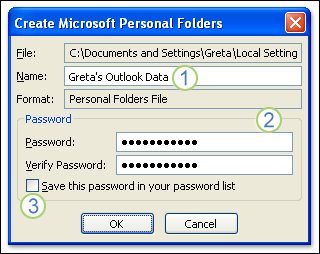


The Import and Export Wizard will start up, you select Export to a file, and click Next.Open your Outlook, and click File > Open & Export > Import/Export.To backup emails in modern Outlook versions, perform the following steps.
#How to create local folder in outlook 365 how to
How to backup Outlook 2013, Outlook 2016 and Outlook 2019 Apart from emails, this will also save contacts, calendars, tasks, and notes. The most safe and reliable way to make an Outlook backup is to let Microsoft Outlook export a. In the second case, having a healthy Outlook backup can significantly alleviate the pain, so it's a wise strategy to back-up your Outlook emails once in a while, especially if you are using email for work.

There may be different situations when you might want to back up Outlook mails - for example, when you are moving to another computer or restoring your Outlook data after a crash. How to backup Outlook emails by exporting
How to backup emails in Outlook Exchange mailbox. Back up Outlook signatures, templates, custom forms and settings. In this tutorial, you will find the detailed instructions on how to backup Outlook mails and other items automatically or manually and learn which method is best to be used in which scenarios. Therefore, if you want to transfer your Outlook account from the old computer to a new one in full, backing up only the. Whilst Outlook emails (as well as calendars, contacts, tasks, and notes) are stored within the Outlook Data File (.pst) file, some other files and settings such as account settings, signatures, templates, custom forms are stored in separate files. If you are using Microsoft Outlook for most of your email communications, there's no need to dwell on how important it is to safely store, import and export all that data. Set objNavFolder = tutorial will teach you to safely back up Outlook emails, contacts, appointments and tasks automatically or manually in all versions of Outlook 2019, Outlook 2016, Outlook 3013, Outlook 2010, and Outlook 2007. Set objModule = (olModuleCalendar)įor i = 1 To This will work with default folders opened using Open Other User's Folder command or any folder shared from a sharing invitation. In order to access a folder received from a folder Invitation (or using Open Other User's folder command), you need find the folder on the navigation pane. NameĪll Public Folders folder in Exchange Public Folders store (Exchange only)Īccess a Folder Opened from a Sharing Invitation The following are the default folder names to use when referencing Outlook's default folders. To add an item to a folder in a shared mailbox, use Items.add: Set newCalFolder = NS.GetSharedDefaultFolder(objOwner, olFolderCalendar) Set objOwner = NS.CreateRecipient("maryc") Set NS = Application.GetNamespace("MAPI") You can use the mailbox owner's display name, alias, or email address when resolving the recipient. If the shared folder was opened from a sharing invitation (or Open Other User's folder command), you may need to use the method in the next section. To access a shared folder in another user's Exchange server mailbox, you need to use GetSharedDefaultFolder to reference the mailbox, after resolving the address to the folder. Set Items = GetFolderPath("New PST\Test Cal").ItemsĪfter adding the function to ThisOutlookSession:įunction GetFolderPath(ByVal FolderPath As String) As Outlook.FolderįolderPath = Right(FolderPath, Len(FolderPath) - 2) Call the function in your macro in this manner, where GetFolderPath is the function name: To use a specific folder in another data file in the profile, you need to use a function. To use the currently selected folder, you'll need to use: Set Items = Session.GetDefaultFolder(olFolderCalendar)._ When the folder is a subfolder under the default Calendar folder, use this instead: Set Items = Session.GetDefaultFolder(olFolderCalendar).Parent._ To use a folder at the same level as the Default folders (such as Calendar, Inbox etc), use this in place of Set Items = Ns.GetDefaultFolder(olFolderCalendar).Items, where SharedCal is the folder name:







 0 kommentar(er)
0 kommentar(er)
